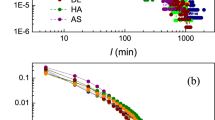Abstract
Flight delays occur in the air transportation system when disruptive events such as weather, equipment outage, or congestion create an imbalance between system capacity and demand. These cycles of disruptions and subsequent recoveries can be viewed from a dynamical systems perspective: exogenous inputs (convective weather, airspace restrictions, etc.) disrupt the system, inducing delays and inefficiencies from which the system eventually recovers. We study these disruption and recovery cycles through a state-space representation that captures the severity and spatial impact of airport delays. In particular, using US airport delay data from 2008 to 2017, we first identify representative disruption and recovery cycles. These representative cycles provide insights into the common operational patterns of disruptions and recoveries in the system. We also relate these representative cycles to specific off-nominal events such as airport outages, and elucidate the differing disruption–recovery pathways for various off-nominal events. Finally, we explore temporal trends in terms of when and how the system tends to be disrupted, and the subsequent recovery.










Similar content being viewed by others
References
Ball, M., Barnhart, C., Nemhauser, G., Odoni, A.: Air transportation: Irregular operations and control. Handbooks Oper. Res. Manag. Sci. 14, 1–67 (2007)
Bureau of Transportation Statistics: Airline On-Time Statistics and Delay Causes (2020)
Clark, K.L., Bhatia, U., Kodra, E.A., Ganguly, A.R.: Resilience of the US national airspace system airport network. IEEE Trans. Intell. Trans. Syst. 19(12), 3785–3794 (2018)
Clausen, J., Larsen, A., Larsen, J., Rezanova, N.J.: Disruption management in the airline industry-concepts, models and methods. Comput. Oper. Res. 37(5), 809–821 (2010)
Cook, A., Delgado, L., Tanner, G., Cristóbal, S.: Measuring the cost of resilience. J. Air Trans. Manag. 56, 38–47 (2016)
Federal Aviation Administration (FAA): Aviation system performance metrics (ASPM) website (2018)
Gopalakrishnan, K., Li, M.Z., Balakrishnan, H.: Identification of outliers in graph signals. In: 58th Conference on Decision and Control (CDC). IEEE (2019)
Janić, M.: Modelling the resilience, friability and costs of an air transport network affected by a large-scale disruptive event. Trans. Res. Part A: policy and practice 71, 1–16 (2015). https://doi.org/10.1016/j.tra.2014.10.023
Kim, S., Lee, J., Oh, S., Yoon, Y.: Assessment of the volcanic hazard of Mt. Paektu explosion to international air traffic using South Korean airspace. Natural Hazards 96(2), 647–667 (2019)
Li, M.Z., Gopalakrishnan, K., Pantoja, K., Balakrishnan, H.: Graph signal processing techniques for analyzing aviation disruptions. Trans. Sci. (2021). https://doi.org/10.1287/trsc.2020.1026
Li, M.Z., Gopalakrishnan, K., Wang, Y., Balakrishnan, H.: Outlier Analysis of Airport Delay Distributions in US and China. In: IEEE Artificial Intelligence and Data Analytics in Air Transportation Conference (2020)
Mukherjee, B., Habib, M.F., Dikbiyik, F.: Network adaptability from disaster disruptions and cascading failures. IEEE Commun. Mag. 52(5), 230–238 (2014)
Office of Inspector General: Although FAA has taken steps to improve its operational contingency plane, significant work remains to mitigate the effects of major system disruptions. Tech. rep, OIG (2017)
Palin, E.J., Scaife, A.A., Wallace, E., Pope, E.C., Arribas, A., Brookshaw, A.: Skillful seasonal forecasts of winter disruption to the UK transport system. J. Appl. Meteorol. Climatol. 55(2), 325–344 (2016)
Shavell, Z.A.: Effects of schedule disruptions on the economics of airline operations. Progress Astronaut. Aeronaut. 193, 115–126 (2001)
Suh, D., Ryerson, M.S.: A large neighborhood search heuristic to establish an optimal ad-hoc hubbing strategy in the wake of a large-scale airport outage. J. Air Trans. Manag. 65, 156–165 (2017)
Wang, Y., Zhan, J., Xu, X., Li, L., Chen, P., Hansen, M.: Measuring the resilience of an airport network. Chin. J. Aeronaut. 32(12), 2694–2705 (2019)
Author information
Authors and Affiliations
Corresponding author
Additional information
Publisher's Note
Springer Nature remains neutral with regard to jurisdictional claims in published maps and institutional affiliations.
This work was supported in part by the National Science Foundation under CPS Award No. 1739505. Max Z. Li was also supported by the Wellington and Irene Loh Fund Fellowship, and an NSF Graduate Research Fellowship. Sang Hyun Shin and Darsh Jalan were supported by the Research Experiences for Undergraduates program at the Department of Industrial and Enterprise Systems Engineering, University of Illinois at Urbana-Champaign.
Appendix
Appendix
See Table 1.
Rights and permissions
About this article
Cite this article
Li, M.Z., Gopalakrishnan, K., Balakrishnan, H. et al. Dynamics of disruption and recovery in air transportation networks. CEAS Aeronaut J 13, 347–357 (2022). https://doi.org/10.1007/s13272-021-00521-x
Received:
Revised:
Accepted:
Published:
Issue Date:
DOI: https://doi.org/10.1007/s13272-021-00521-x




